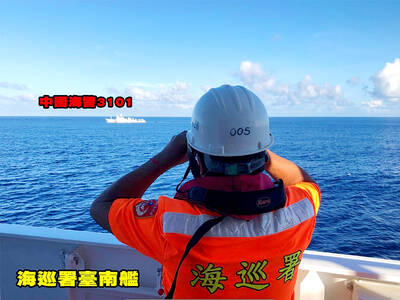Taiwanese researchers at a biotechnology fair in Taipei have showcased the initial results of their efforts to map fruit flies’ brains, which they said will pave the way for mapping the human brain to find treatments for diseases that cannot be cured today.
“Just like humans, fruit flies can also suffer from Alzheimer’s disease, Parkinson’s disease, depression, attention-deficit hyperactivity disorder (ADHD) or autism,” said Chiang Ann-shyn (江安世), director of National Tsing Hua University’s Brain Research Center, on the sidelines of the Bio Taiwan fair that runs from Thursday to today.
More understanding
“When we understand the neural circuits of a fruit fly’s brain, we will be able to know which neuronal cells or genes go wrong and then fix them,” he said.
Chiang, in charge of the project, said the research team’s technology allows 3D visualization of internal structures at cellular and sub-cellular levels, with high resolution and without tissue embedding and sectioning.
The same concept can be applied to eventually mapping and understanding the human brain, Chiang said.
BRAIN MAP
“The key thing we lack today is such a brain map,” he said. “We hope to create a Google Earth of the human brain in the future and provide it to scientists around the world to use.”
“In the future, scientists can just use this system and search for certain brain networks or gene expressions,” he said.
The field of brain mapping is at the cutting edge of biotechnology. Only a small number of top institutes in the world are undertaking such research.
The government has already identified the research team’s technologies as one of the country’s six potential star industries in the future.
So far, the Chiang-led research team has achieved initial results in mapping a small part of a fruit fly’s brain, which has 130,000 neurons, but a human brain is 100,000 times more complex than that of a fruit fly.
3D TECHNOLOGY
Chiang also envisions that in 10 years, medical doctors will be able to rely on a 3D visualization of every human organ to facilitate their treatment of diseases.
At the fair, the research team set up a small theater to allow visitors to see a 3D presentation of the mapped parts of a fruit fly’s brain on a big screen.
The research team colored different neurons in the 3D picture of the brain, which can be turned horizontally and vertically, and can be zoomed in and out, to help viewers better understand the structure of the neurological systems.
Yao Chih-min (姚志明), deputy director-general of the National Center for High-Performance Computing, who is part of the research team, explained why the team chose fruit flies as the subject of their experiments.
“It’s because they are low-cost and easy to obtain, “ he said. “You can get only one single neuron when you kill a fruit fly, so you can imagine how many of them have been sacrificed in order to build the database we see now.”
Chiang urged the government to help step up development of this field as rival foreign research teams have allocated far more investment and resources than Taiwan.
“Other countries also see this field as the future and they can outperform us, even though they started later than we did,” he said.
It will take a long time for any team in the world to map the human brain because of its complexity, Yao said.

The Coast Guard Administration (CGA) yesterday said it had deployed patrol vessels to expel a China Coast Guard ship and a Chinese fishing boat near Pratas Island (Dongsha Island, 東沙群島) in the South China Sea. The China Coast Guard vessel was 28 nautical miles (52km) northeast of Pratas at 6:15am on Thursday, approaching the island’s restricted waters, which extend 24 nautical miles from its shoreline, the CGA’s Dongsha-Nansha Branch said in a statement. The Tainan, a 2,000-tonne cutter, was deployed by the CGA to shadow the Chinese ship, which left the area at 2:39pm on Friday, the statement said. At 6:31pm on Friday,

The Chinese People’s Liberation Army Navy’s (PLAN) third aircraft carrier, the Fujian, would pose a steep challenge to Taiwan’s ability to defend itself against a full-scale invasion, a defense expert said yesterday. Institute of National Defense and Security Research analyst Chieh Chung (揭仲) made the comment hours after the PLAN confirmed the carrier recently passed through the Taiwan Strait to conduct “scientific research tests and training missions” in the South China Sea. China has two carriers in operation — the Liaoning and the Shandong — with the Fujian undergoing sea trials. Although the PLAN needs time to train the Fujian’s air wing and

STRIKE: Some travel agencies in Taiwan said that they were aware of the situation in South Korea, and that group tours to the country were proceeding as planned A planned strike by airport personnel in South Korea has not affected group tours to the country from Taiwan, travel agencies said yesterday. They added that they were closely monitoring the situation. Personnel at 15 airports, including Seoul’s Incheon and Gimpo airports, are to go on strike. They announced at a news conference on Tuesday that the strike would begin on Friday next week and continue until the Mid-Autumn Festival next month. Some travel agencies in Taiwan, including Cola Tour, Lion Travel, SET Tour and ezTravel, said that they were aware of the situation in South Korea, and that group

Taiwanese celebrities Hank Chen (陳漢典) and Lulu Huang (黃路梓茵) announced yesterday that they are planning to marry. Huang announced and posted photos of their engagement to her social media pages yesterday morning, joking that the pair were not just doing marketing for a new show, but “really getting married.” “We’ve decided to spend all of our future happy and hilarious moments together,” she wrote. The announcement, which was later confirmed by the talent agency they share, appeared to come as a surprise even to those around them, with veteran TV host Jacky Wu (吳宗憲) saying he was “totally taken aback” by the news. Huang,